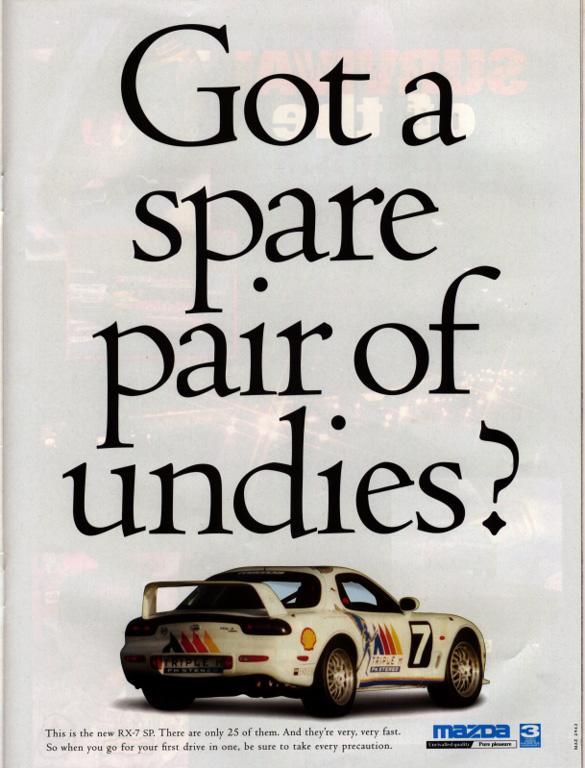- 613
- TWNTYB_4ME
- F Caris
Since its introduction in 1992, the series 6 RX-7 proved a highly competitive car not only here in Australia, but in the USA and throughout the world. Since the elimination of the rotary in Group A racing in 1984, Mazda Australia had only production car racing to expose its 13B turbo rotary-engined cars to the racetracks of Australia. The twin-turbo RX-7 made its 12 Hour debut in 1992 in the hands of Charlie O'Brien, Mark Gibbs and the late Gregg Hansford, who drove it to victory.
In 1995, the RX-7 SP was born. Something impressive about the RX-7 SP is how quickly and efficiently it was developed - local development and production of the parts obviously helped. With the introduction of 1995's new regulations, according to Mazda's PR Steve Rowland 'in February the SP was still an idea in Allan's (Horsley's) head'. Three months and apparently less than $ 10,000 in total development costs later, Horsley and head spanner Daniel Deckers rolled the RX-7 SP out of its Kingsgrove workshop - a potential GT-P and 12 Hour winner.
The list of exact changes made to convert a standard Australian-spec twin-turbo RX-7 to 'SP' specs numbers 60. Most notable is the front nose cone which has a greatly increased air intake (necessitating the extra strength of the carbon fibre) and rear spoiler; both made from carbon fibre, they produce noticeably more downforce with the obvious lighter-than-plastic weight advantage. 'We tested the rear spoiler in three different guises out here (Eastern Creek),' informed Garry Waldon: no spoiler at all, the factory spoiler and the high mount version - which won favour. 'The small standard spoiler proved it was faster around Eastern Creek than no spoiler at all but the high-mount was around six-to-seven-tenths quicker again.' The notorious Turn One sweeper is where the rear spoiler benefits most, raising the car's corner speed 5km/h 'You can really feel the increased downforce around here," added Waldon who hustled through the sweeper during the race consistently over 200 km/h.
More carbon fibre is used under the lightweight and vented aluminum bonnet: the Mazda-motif air-box with ram-air ducting and pipework and, most notably visible from under the rear, the huge carbon-fibre fuel tank which boosts fuel capacity (and the distance between fuel stops) from 76 to 110 litres. The SP also gets stainless steel heat-shielding between the fuel tank and the revised from the turbo free-flowing exhaust system.
Fuel tank capacity, in the 12 Hour, proved to be a contributing factor to the SP's success with longer track sessions. Horsley's wild card was his well-publicized 'cool fuel'. Stored in large alloy tanks at the track, the 100 octane unleaded was chilled with dry ice to a temperature of around 5 deg C. When the 110 or so litres of fuel was dumped in at each stop, the almost freezing fuel lowered combustion temperatures noticeably for the entire session - a vital parameter with heat-stressed rotaries and turbos ensuring thermal loading was kept as low as possible.



In 1995, the RX-7 SP was born. Something impressive about the RX-7 SP is how quickly and efficiently it was developed - local development and production of the parts obviously helped. With the introduction of 1995's new regulations, according to Mazda's PR Steve Rowland 'in February the SP was still an idea in Allan's (Horsley's) head'. Three months and apparently less than $ 10,000 in total development costs later, Horsley and head spanner Daniel Deckers rolled the RX-7 SP out of its Kingsgrove workshop - a potential GT-P and 12 Hour winner.
The list of exact changes made to convert a standard Australian-spec twin-turbo RX-7 to 'SP' specs numbers 60. Most notable is the front nose cone which has a greatly increased air intake (necessitating the extra strength of the carbon fibre) and rear spoiler; both made from carbon fibre, they produce noticeably more downforce with the obvious lighter-than-plastic weight advantage. 'We tested the rear spoiler in three different guises out here (Eastern Creek),' informed Garry Waldon: no spoiler at all, the factory spoiler and the high mount version - which won favour. 'The small standard spoiler proved it was faster around Eastern Creek than no spoiler at all but the high-mount was around six-to-seven-tenths quicker again.' The notorious Turn One sweeper is where the rear spoiler benefits most, raising the car's corner speed 5km/h 'You can really feel the increased downforce around here," added Waldon who hustled through the sweeper during the race consistently over 200 km/h.
More carbon fibre is used under the lightweight and vented aluminum bonnet: the Mazda-motif air-box with ram-air ducting and pipework and, most notably visible from under the rear, the huge carbon-fibre fuel tank which boosts fuel capacity (and the distance between fuel stops) from 76 to 110 litres. The SP also gets stainless steel heat-shielding between the fuel tank and the revised from the turbo free-flowing exhaust system.
Fuel tank capacity, in the 12 Hour, proved to be a contributing factor to the SP's success with longer track sessions. Horsley's wild card was his well-publicized 'cool fuel'. Stored in large alloy tanks at the track, the 100 octane unleaded was chilled with dry ice to a temperature of around 5 deg C. When the 110 or so litres of fuel was dumped in at each stop, the almost freezing fuel lowered combustion temperatures noticeably for the entire session - a vital parameter with heat-stressed rotaries and turbos ensuring thermal loading was kept as low as possible.



